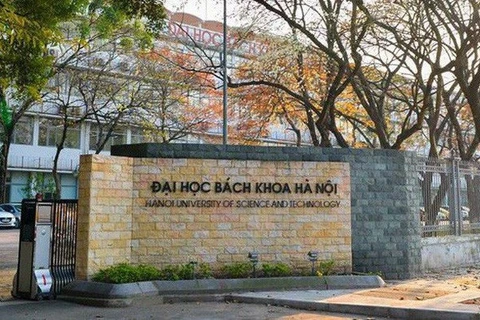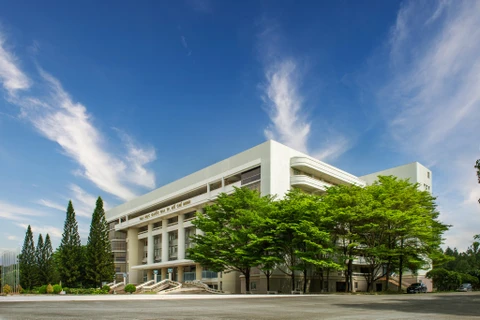Hanoi (VNA) – The building of standards for Vietnamese higher education institutions should be based on data collected from universities and international experience, according to Deputy Minister of Education and Training Hoang Minh Son.
A draft circular on the standards of higher education institutions, introduced by the Ministry of Education and Training (MoET), has drawn great attention from higher education establishments as it regulates requirements to be met. Although a draft was started in 2021, the circular, which has received hundreds of ideas, has yet to be issued.
Deputy Minister of Education and Training Hoang Minh Son spoke to the media on this important document.
Reporter: Could you please clarify the objectives of the draft circular on the standards of higher education institutions?
Deputy Minister Hoang Minh Son: All the standards set out in the circular stipulating those of higher education institutions will be the minimum requirements for the institutions to maintain operations. This is also the basis for monitoring the conditions on quality and a way to minimise risks to stakeholders. These include the State, businesses, and especially students because they have invested money, time and youth in the institutions. Standards also help students self-assess their education institutions through specific and objective data instead of consulting subjective opinions.
With the clarification of minimum requirements, the circular aims to reinforce and enhance the quality of higher education. Meanwhile, along with the implementation of education planning, universities will have to invest more in themselves to ensure their quality in order to reach and exceed the standards.
Reporter: What are the difference between these standards and the educational quality accreditation criteria that the universities are applying?
Deputy Minister Hoang Minh Son: What makes standards for higher education institutions different from the accreditation standards for the institutions include their purpose, nature, content and implementation procedures.
 MoET Deputy Minister Hoang Minh Son addresses a seminar to gather ideas from universities for the completion of the draft circular on standards for higher education institutions (Photo: VietnamPlus)
MoET Deputy Minister Hoang Minh Son addresses a seminar to gather ideas from universities for the completion of the draft circular on standards for higher education institutions (Photo: VietnamPlus) In simple terms, the standards for higher education institutions consist of the indicators on operational status read from a snapshot, including threshold values for easy comparison. Just like when we take a scan, measure blood pressure or take a blood test, we will receive common indicators so that everyone can compare with the threshold values to see if there is any abnormality in our health.
Meanwhile, quality evaluation and control is much complicated as it is necessary to look into the whole process of operations for years based on standards and criteria. Most of these are qualitative, while comparing with the missions and purposes of the particular establishment. This process needs the analysis and intensive evaluation from experts who also give recommendations for improvement. It’s like we need doctors to examine our health, diagnose our problems and the reasons behind our diseases (in some cases, it requires professional discussions), and decide on the treatment protocol.
Standards for higher education facilities are the minimum requirements that any establishment must satisfy, while accreditation standards vary in different institutions depending on their particular missions and purposes. But the evaluation following criteria and accreditation standards need to comply with the minimum requirements specified by the higher education institution standards. It means even though a school meets the standards, if it’s mission and goals are too high, it may not pass the test.
The indicators for higher education institution standards must be monitored and supervised regularly and announced every year, allowing students and society to access and supervise. Meanwhile, the evaluating and examination activities are implemented every five years to make a full and comprehensive report, laying the foundation for the higher education institution to design a strategy for improvement.
 According to Deputy Minister Hoang Minh Son, the building of standards for higher education institutions must put students in the centre and ensure their interest (Photo: VietnamPlus)
According to Deputy Minister Hoang Minh Son, the building of standards for higher education institutions must put students in the centre and ensure their interest (Photo: VietnamPlus) Reporter: Currently, Vietnam has 242 universities. Could you please clarify what foundation the MoET bases this on while giving the standards, criteria and the baseline for higher education institutions, thus making sure that they can be applicable for all establishments?
Deputy Minister Hoang Minh Son: This is the toughest issue and one of the reasons why the draft circular has yet to be issued after three years. It is not too difficult to reach consensus of the six groups of standards, but in each group, what the necessary and minimum standards are and how to set the standard baseline are among issues that need discussion.
The ministry’s stance is the criteria must be simple, easy to calculate and quantify, but they must comprehensively and fully indicate the crucial requirements for a higher education establishment to operate normally.
The drafting agency and the advisory experts for the building of the standards have consulted many different sources of information.
Firstly, we apply practical experience in State management of the MoET that has been built for years as well as experience in the renovation process of universities.
Secondly, we learn from other countries, international organisations, foreign universities and see how they have done and what are important for them. There are some very popular criteria such as the measurements of quality through the ratio of employed students after graduation, but there are some new indicators for us. For example, regarding finance, for years we have hardly paid attention to this issue, but other countries have given very clear criteria which can evaluate the financial situation of facilities, thus evaluating risks to investors and students from the operations of the facilities.
Regarding practical data, we have two sources – the shared data of the MoET, and data provided by universities through the ministry’s survey which covers 142 universities. From this data, we compare them with that of other countries, and give a standard baseline at a suitable level, thus gradually integrate into the world but still ensure its feasibility.
 Leaders of universities at a discussion on standards for higher education facilities (Photo: VietnamPlus)
Leaders of universities at a discussion on standards for higher education facilities (Photo: VietnamPlus) We have discussed with and collected opinions from universities. Of course, if all institutions meet the standards, then there is probably no need for standards, therefore, it is necessary to set a higher baseline to gradually raise their quality. With institutions that are above the baseline, they will definitely strive to show higher indicators because the standards are only the base level.
Reporter: For facilities that fail to meet the standards, what punishments will the MoET apply on them?
Deputy Minister Hoang Minh Son: Of course, universities that fail to meet the standards will receive punishments, but the punishments are not specified in this circular but in many other documents, such as in Government decrees. Accordingly, standards for higher education institutions comprise six standards with 24 criteria and 29 indicators. It is crucial to find out what criteria and indicators that the facilities fail to meet and why.
For example, if an institution enrolls too many students, it will definitely have to reduce the following year's enrollment target to meet the student-faculty ratio. If a public university shows inefficient operations for many years, reflected through high levels of risk in its financials or enrollment indicators and underinvestment from the host institution, it will must be considered for reshuffling.
Reporter: Baseline indicators are very important. So what will the MoET do to make sure that the data are reliable, especially those measured by the institutions themselves such as the satisfaction of students or the ratio of students get a job after graduation?
Deputy Minister Hoang Minh Son: The set of standards must be built based on reliable data over which the MoET, the society and universities can supervise.
Currently, the MoET has completed a higher education management information system (HEMIS) for universities to update their data on new, current and graduating students each year, faculty, facilities and campus infrastructure. These are the original data to calculate the indicators and make a control mechanism forcing the institutions to update their data in a full and accurate manner.
In the immediate future, data such as the percentage of employed graduate students, and student satisfaction will be declared by the institutions themselves based on the results of the annual student surveys. But the ministry will also have a mechanism to control it through sample survey tools. Currently, the ministry is coordinating with the Vietnam Social Security to connect graduate data with workplace information. In the near future, it will provide objective information about the employment status of graduates in particular major and field of each training institution.
Reporter: Will the data be calculated for the whole institution, or will it be disaggregated by each training facility, sub-institution or even faculty? Because of the fact that some universities have spacious branches with few students, while the main campus is small but more crowded, or there are training majors with a large number of students and some with few?
Deputy Minister Hoang Minh Son: The current draft circular stipulates indicators applicable to higher education institutions as a whole and a number of indicators for their branches.
Requirements for different areas and sectors (such as requirements in land area, construction area, and the student-faculty ratio) have been considered as the adjustment factors in the formula for calculating the indicators.
Other specific requirements of each training field or industry (for example, requirements for practice facilities in the field of health, or the group of majors in teacher training) that are not specified in this standard set will be stipulate in the training programme standards of particular training field or group of training sectors.
This means the standards for higher education facilities and standards for training programmes will be turned into a coherent system meeting the common requirements for each higher education institution, while satisfying particular and specific requirements for each training areas.
Reporter: Thank you very much!

























